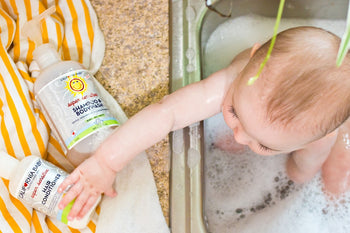After ten years of searching, Jessica found the property to turn her dreams of growing California Baby’s own calendula flower into a blossoming reality: a 100-acre vineyard ripe for conversion to organic in the rolling hills of California’s central coast. The transformation from monoculture to organic, however, would take another three years — driven by Jessica’s commitment to getting it right not only for the integrity of our formulas but for the health of the environment.

Our organic calendula field in full bloom
But first, what’s the difference between organic and industrial farming?
Industrial farming (or large-scale monoculture) is currently the dominant food production system in the United States. In a nutshell, industrial agriculture relies on synthetic intervention like chemical fertilizers, pesticides and herbicides to add nutrients and fight pests and weeds.
Organic farmers rely on natural, synthetic-free approaches — some of them thousands of years old — like biodiversity, composting and no-till cover cropping to produce not just healthy, pesticide-free foods but a thriving ecosystem as well.
Going organic: How Jessica converted a vineyard to an organic farm
California Baby is best known for our calendula-infused skincare line, especially the fan-favorite Calendula Cream. The calendula we grow on our organic farm yields a more pure, ultra-concentrated extract for our baby products. But you’ll find more than hilltop fields bursting with the bright yellow and orange of calendula flowers here, much more. Birds and bees and the ocean breeze are all part of our ecosystem — snakes, coyotes, redtail hawks and wild pigs, too. Most recently, we added French lavender to our growing organic farm.
Every plant, animal and organic farming practice plays a role in the high quality of our calendula extract. Getting here was a years-long process that started in 2011 and in many ways is still a work in progress as we continuously strive for ever-more sustainable methods. After cutting new roads and clearing acres of brush, the real work began to transform a mono-crop vineyard into the organic farm we have today:

We love our honey bees! They help pollinate our farm
Soil restoration
Weeds and seeds can lie dormant in the soil for years, then suddenly wake up if you start watering them. Before Jessica could plant anything, she first had to restore the soil through solarization — a natural method that involves turning and leveling the soil, irrigating it up to 12 inches and covering it in recycled plastic. The water awakens all those sleeping weeds and seeds, then the sun bakes them for four to six weeks, clearing the soil. It’s more time-consuming than dumping roundup on the problem but keeps our soil and groundwater free of agrochemical runoff.
Solar power
Renewable solar energy is part of our DNA. Where once rows of grapevines stood, now rows of solar panels power the farm. It took two years of planning and implementing, but today up to 100% percent of our calendula flower farm’s energy is solar powered.

These solar panels power our farm!
Cover cropping
Cover crops are grown to improve soil health by preventing nutrient loss and erosion. They also help naturally control weeds, pests and disease during the off-season after the cash crop has been harvested. Organic farmers use this method as an alternative to tilling with a plow to help naturally regenerate the soil without disrupting its underground fungal network or increasing erosion.
California Baby started cover cropping the first year Jessica purchased the farm in 2011 to help replenish nutrients like nitrogen and maintain the structure and health of the soil. Our cover crops, including bell beans, peas, vetch and barley, also help prevent topsoil loss and keep the soil from compacting into hard, unusable dirt.
Composting and mulching
Compost, a mix of fully decomposed plant material and animal manure, is high in carbon, nitrogen and healthy biota — all good things for soil’s nutrient composition. Mulch is partially decomposed plant material that’s placed as topsoil for insulation, water retention and some nutrients.
We create our own mulch on the farm with a mix of native soil, water and plant material from crop trimmings, excess moss from our pond, underwater grass and leaves from our orchard and surrounding trees. We also purchase certified organic compost as needed, depending on the specific nutrients our soil needs.
Planting an orchard and roses
Our orchard of olive, stone fruit and citrus leaves and grove of heritage roses do more than scent the farm. They support the whole ecosystem by creating a vital food source for local bees when in bloom, which in turn support the vitality of our calendula flowers. When pruned, their scraps (leaves, fruit and small branches) go back into the soil and help create barriers against erosion.

Why organic? Longterm health over short-term gains
Like everything else we do at California Baby, we approach our farm with the long-term in mind. What impact will our choices today have sixty, seventy, a hundred years from now? For Jessica, going organic meant more quality control over the purity of her calendula flowers — the signature, soothing ingredient at the heart of California Baby’s formulas — and a more secure, environmentally sound future for the farm, her family and the land.
What does it mean to be USDA Certified Organic?
USDA-certified organic foods and products meet federally regulated guidelines on soil quality, pest and weed control, and additives to name a few. The USDA organic label is backed by a Federal certification process that verifies farmers are following federal regulations. This means that an Organic inspector shows up at California Baby’s farm every year to make sure we’re walking the walk, not just talking the talk. Getting certified is no walk in the park, either. The multi-step process includes developing a system plan specific to your farm or operation that details everything from tilling and grazing to harvesting and transporting — then proving that plan in action, under the scrutiny of an inspector.
The takeaway
Sure it’s more labor-intensive and costs more upfront to grow and handpick our own organic calendula flowers. But simpler, faster and easier doesn’t always pay off. California Baby’s decision years ago to go organic protects our farm and ecosystem from the crop collapse threatening industrial monoculture methods today. Earning the label to back up our organic claim is just one way we give parents and shoppers confidence that we’re walking the walk, not just talking the marketing talk. We believe the investment in our future and yours is well worth it.















